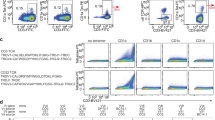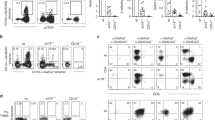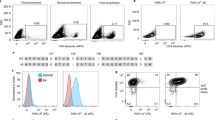Abstract
The hallmark function of αβ T cell antigen receptors (TCRs) involves the highly specific co-recognition of a major histocompatibility complex molecule and its carried peptide. However, the molecular basis of the interactions of TCRs with the lipid antigen–presenting molecule CD1c is unknown. We identified frequent staining of human T cells with CD1c tetramers across numerous subjects. Whereas TCRs typically show high specificity for antigen, both tetramer binding and autoreactivity occurred with CD1c in complex with numerous, chemically diverse self lipids. Such extreme polyspecificity was attributable to binding of the TCR over the closed surface of CD1c, with the TCR covering the portal where lipids normally protrude. The TCR essentially failed to contact lipids because they were fully seated within CD1c. These data demonstrate the sequestration of lipids within CD1c as a mechanism of autoreactivity and point to small lipid size as a determinant of autoreactive T cell responses.
This is a preview of subscription content, access via your institution
Access options
Access Nature and 54 other Nature Portfolio journals
Get Nature+, our best-value online-access subscription
$29.99 / 30 days
cancel any time
Subscribe to this journal
Receive 12 print issues and online access
$209.00 per year
only $17.42 per issue
Buy this article
- Purchase on Springer Link
- Instant access to full article PDF
Prices may be subject to local taxes which are calculated during checkout








Similar content being viewed by others
References
Rossjohn, J. et al. T cell antigen receptor recognition of antigen-presenting molecules. Annu. Rev. Immunol. 33, 169–200 (2015).
Van Rhijn, I., Godfrey, D. I., Rossjohn, J. & Moody, D. B. Lipid and small-molecule display by CD1 and MR1. Nat. Rev. Immunol. 15, 643–654 (2015).
Adams, E. J. & Luoma, A. M. The adaptable major histocompatibility complex (MHC) fold: structure and function of nonclassical and MHC class I-like molecules. Annu. Rev. Immunol. 31, 529–561 (2013).
Godfrey, D. I., Uldrich, A. P., McCluskey, J., Rossjohn, J. & Moody, D. B. The burgeoning family of unconventional T cells. Nat. Immunol. 16, 1114–1123 (2015).
Gadola, S. D. et al. Structure of human CD1b with bound ligands at 2.3 A, a maze for alkyl chains. Nat. Immunol. 3, 721–726 (2002).
Zajonc, D. M. et al. Structure and function of a potent agonist for the semi-invariant natural killer T cell receptor. Nat. Immunol. 6, 810–818 (2005).
Zajonc, D. M., Elsliger, M. A., Teyton, L. & Wilson, I. A. Crystal structure of CD1a in complex with a sulfatide self antigen at a resolution of 2.15 A. Nat. Immunol. 4, 808–815 (2003).
Scharf, L. et al. The 2.5 Å structure of CD1c in complex with a mycobacterial lipid reveals an open groove ideally suited for diverse antigen presentation. Immunity 33, 853–862 (2010).
Koch, M. et al. The crystal structure of human CD1d with and without alpha-galactosylceramide. Nat. Immunol. 6, 819–826 (2005).
Rossjohn, J., Pellicci, D. G., Patel, O., Gapin, L. & Godfrey, D. I. Recognition of CD1d-restricted antigens by natural killer T cells. Nat. Rev. Immunol. 12, 845–857 (2012).
Gras, S. et al. T cell receptor recognition of CD1b presenting a mycobacterial glycolipid. Nat. Commun. 7, 13257 (2016).
Shahine, A. et al. A molecular basis of human T cell receptor autoreactivity toward self-phospholipids. Sci. Immunol. 2, eaao1384 (2017).
Birkinshaw, R. W. et al. αβ T cell antigen receptor recognition of CD1a presenting self lipid ligands. Nat. Immunol. 16, 258–266 (2015).
de Lalla, C. et al. High-frequency and adaptive-like dynamics of human CD1 self-reactive T cells. Eur. J. Immunol. 41, 602–610 (2011).
Roy, S. et al. Molecular analysis of lipid-reactive Vδ1 γδ T cells identified by CD1c tetramers. J. Immunol. 196, 1933–1942 (2016).
Roy, S. et al. Molecular basis of mycobacterial lipid antigen presentation by CD1c and its recognition by αβ T cells. Proc. Natl. Acad. Sci. USA 111, E4648–E4657 (2014).
Bagchi, S. et al. CD1b-autoreactive T cells contribute to hyperlipidemia-induced skin inflammation in mice. J. Clin. Invest. 127, 2339–2352 (2017).
Van Rhijn, I. et al. Human autoreactive T cells recognize CD1b and phospholipids. Proc. Natl. Acad. Sci. USA 113, 380–385 (2016).
Matulis, G. et al. Innate-like control of human iNKT cell autoreactivity via the hypervariable CDR3beta loop. PLoS Biol. 8, e1000402 (2010).
Mallevaey, T. et al. A molecular basis for NKT cell recognition of CD1d-self-antigen. Immunity 34, 315–326 (2011).
Gumperz, J. E. et al. Murine CD1d-restricted T cell recognition of cellular lipids. Immunity 12, 211–221 (2000).
de Jong, A. et al. CD1a-autoreactive T cells are a normal component of the human αβ T cell repertoire. Nat. Immunol. 11, 1102–1109 (2010).
de Jong, A. et al. CD1a-autoreactive T cells recognize natural skin oils that function as headless antigens. Nat. Immunol. 15, 177–185 (2014).
Bourgeois, E. A. et al. Bee venom processes human skin lipids for presentation by CD1a. J. Exp. Med. 212, 149–163 (2015).
Kim, J. H. et al. CD1a on Langerhans cells controls inflammatory skin disease. Nat. Immunol. 17, 1159–1166 (2016).
Subramaniam, S. et al. Elevated and cross-responsive CD1a-reactive T cells in bee and wasp venom allergic individuals. Eur. J. Immunol. 46, 242–252 (2016).
Mansour, S. et al. Cholesteryl esters stabilize human CD1c conformations for recognition by self-reactive T cells. Proc. Natl. Acad. Sci. USA 113, E1266–E1275 (2016).
Lepore, M. et al. Targeting leukemia by CD1c-restricted T cells specific for a novel lipid antigen. OncoImmunology 4, e970463 (2014).
Yakimchuk, K. et al. Borrelia burgdorferi infection regulates CD1 expression in human cells and tissues via IL1-β. Eur. J. Immunol. 41, 694–705 (2011).
Roura-Mir, C. et al. CD1a and CD1c activate intrathyroidal T cells during Graves’ disease and Hashimoto’s thyroiditis. J. Immunol. 174, 3773–3780 (2005).
Lepore, M. et al. A novel self-lipid antigen targets human T cells against CD1c+ leukemias. J. Exp. Med. 211, 1363–1377 (2014).
Ly, D. et al. CD1c tetramers detect ex vivo T cell responses to processed phosphomycoketide antigens. J. Exp. Med. 210, 729–741 (2013).
Altman, J. D. et al. Phenotypic analysis of antigen-specific T lymphocytes. Science 274, 94–96 (1996).
Guo, T. et al. A subset of human autoreactive CD1c-restricted T cells preferentially expresses TRBV4–1+ TCRs. J. Immunol. 200, 500–511 (2018).
Porcelli, S., Morita, C. T. & Brenner, M. B. CD1b restricts the response of human CD4–8– T lymphocytes to a microbial antigen. Nature 360, 593–597 (1992).
Yin, Y., Li, Y. & Mariuzza, R. A. Structural basis for self-recognition by autoimmune T-cell receptors. Immunol. Rev. 250, 32–48 (2012).
Melenhorst, J. J. et al. Contribution of TCR-β locus and HLA to the shape of the mature human Vβ repertoire. J. Immunol. 180, 6484–6489 (2008).
Dougan, S. K., Kaser, A. & Blumberg, R. S. CD1 expression on antigen-presenting cells. Curr. Top. Microbiol. Immunol. 314, 113–141 (2007).
Vincent, M. S. et al. CD1-dependent dendritic cell instruction. Nat. Immunol. 3, 1163–1168 (2002).
Bligh, E. G. & Dyer, W. J. A rapid method of total lipid extraction and purification. Can. J. Biochem. Physiol. 37, 911–917 (1959).
Layre, E. et al. A comparative lipidomics platform for chemotaxonomic analysis of Mycobacterium tuberculosis. Chem. Biol. 18, 1537–1549 (2011).
Huang, S. et al. Discovery of deoxyceramides and diacylglycerols as CD1b scaffold lipids among diverse groove-blocking lipids of the human CD1 system. Proc. Natl Acad. Sci. USA 108, 19335–19340 (2011).
Madigan, C. A. et al. Lipidomic discovery of deoxysiderophores reveals a revised mycobactin biosynthesis pathway in Mycobacterium tuberculosis. Proc. Natl. Acad. Sci. USA 109, 1257–1262 (2012).
Young, D. C. et al. In vivo biosynthesis of terpene nucleosides provides unique chemical markers of Mycobacterium tuberculosis infection. Chem. Biol. 22, 516–526 (2015).
Gras, S. et al. Allelic polymorphism in the T cell receptor and its impact on immune responses. J. Exp. Med. 207, 1555–1567 (2010).
Wang, G. C., Dash, P., McCullers, J. A., Doherty, P. C. & Thomas, P. G. T cell receptor αβ diversity inversely correlates with pathogen-specific antibody levels in human cytomegalovirus infection. Sci. Transl. Med. 4, 128ra42 (2012).
Holst, J., Vignali, K. M., Burton, A. R. & Vignali, D. A. A. Rapid analysis of T-cell selection in vivo using T cell-receptor retrogenic mice. Nat. Methods 3, 191–197 (2006).
Uldrich, A. P. et al. CD1d-lipid antigen recognition by the γδ TCR. Nat. Immunol. 14, 1137–1145 (2013).
Aricescu, A. R., Lu, W. & Jones, E. Y. A time- and cost-efficient system for high-level protein production in mammalian cells. Acta Crystallogr. D Biol. Crystallogr. 62, 1243–1250 (2006).
Kjer-Nielsen, L. et al. A structural basis for the selection of dominant αβ T cell receptors in antiviral immunity. Immunity 18, 53–64 (2003).
Pellicci, D. G. et al. Differential recognition of CD1d-alpha-galactosyl ceramide by the Vβ8.2 and Vβ7 semi-invariant NKT T cell receptors. Immunity 31, 47–59 (2009).
Winn, M. D. et al. Overview of the CCP4 suite and current developments. Acta Crystallogr. D Biol. Crystallogr. 67, 235–242 (2011).
Strong, M. et al. Toward the structural genomics of complexes: crystal structure of a PE/PPE protein complex from Mycobacterium tuberculosis. Proc. Natl. Acad. Sci. USA 103, 8060–8065 (2006).
McCoy, A. J. Solving structures of protein complexes by molecular replacement with Phaser. Acta Crystallogr. D Biol. Crystallogr. 63, 32–41 (2007).
Bricogne, G. et al. autoBUSTER, Version 1.6.0. Global Phasing Ltd, Cambridge, United Kingdom. (2011).
Emsley, P., Lohkamp, B., Scott, W. G. & Cowtan, K. Features and development of Coot. Acta Crystallogr. D Biol. Crystallogr. 66, 486–501 (2010).
Acknowledgements
We thank S. A. Porcelli (Albert Einstein College of Medicine, New York) for the 3C8 T cell clone; the Monash Macromolecular crystallization Facility staff for assistance with crystallization and the staff at the Australian synchrotron for assistance with data collection; D. Ly for advice on tetramer staining patterns; and L. L. Tan, H. Halim and N. Williams for technical assistance. Supported by the US National Institutes of Health (R01 AR048632, R01 AI049313 and AI U19111224), the Australian Research Council (Laureate Fellowship to J.R.), the National Health and Medical Research Council (Early Career Fellowship to K.S.W.) and the Wellcome Trust (Senior Investigator Award to D.A.P.).
Author information
Authors and Affiliations
Contributions
K.S.W. undertook research, including the structural biology and surface plasmon resonance experiments, produced CD1c-lipid and TCR-CD1c-lipid complexes and analyzed data; J.F.R. produced CD1c-lipid complexes and isolated and analyzed T cell clones; T.-Y.C. eluted lipids for identification by MS; J.F.R., K.L., A.P.U., K.L.M., J.E.M., S.S., S.I., J.D.A., J.J.M. and I.V.R. generated tetramers or conducted tetramer staining experiments; K.L., J.J., S.R.L. and M.M. recruited and carried out clinical studies of healthy donors; J.L.N., E.J.G., O.L.H., T.S.W., R.C., K.L.T. and J.D.A. either provided key reagents or analyzed data; J.A.M. provided statistical analysis; K.L., A.W.P., D.I.G., S.G., D.A.P. and I.V.R. provided oversight for experiments and/or contributed to writing the paper; and D.B.M. and J.R. conceived of the project, provided oversight and wrote the paper.
Corresponding authors
Ethics declarations
Competing interests
The authors declare no competing interests.
Additional information
Publisher’s note: Springer Nature remains neutral with regard to jurisdictional claims in published maps and institutional affiliations.
Integrated supplementary information
Supplementary Figure 1 Gating ancestry for tetramer stains in Fig. 1 and Supplementary Fig. 2.
(a) Gating ancestry for the CD1c-endo tetramer stains shown in Figure 1a (CD3+CD14–CD19–) and Supplemental Figure 2 (CD3–CD14–CD19–). (b) Gating ancestry for the CD1-endo and CD1b-endo tetramer stains and graphed data shown in Figure 1b and 1c.
Supplementary Figure 2 CD1c-endo tetramer binding to CD3– cells
CD1c-endo tetramer staining of live CD3–CD14–CD19– cells, pre-gated as shown in Supplementary Figure 1a. The corresponding CD1c-endo tetramer stains for CD3+CD14–CD19– cells are shown in Figure 1a.
Supplementary Figure 3 Sequence alignment of the different human CD1 isoforms
Residues on the CD1c α-helices that interacted with the 3C8 TCR are highlighted. Alanine-substituted residues are highlighted to indicate effects on CD69 expression by J76.3C8 cells: > 50% decrease, red; < 25% decrease, green. Residues that were not substituted are colored purple. * identical residue; : conserved residue;. conserved residue in 3 CD1 isoforms.
Supplementary Figure 4 Collision induced dissociation mass spectrometry of the CD1c ligand
Collision induced dissociation mass spectrometry of the CD1c ligand of m/z 359.316 is identified as monoacylglycerol (MAG) based on fragments corresponding to a single fatty acid (m/z 285.279) and a mass interval corresponding to glycerol. This pattern matches that derived from an authentic MAG standard.
Supplementary Figure 5 Reversed-phase analysis of lipids eluted from CD1c or 3C8 TCR–CD1c in HPLC-TOF-MS
Ions matching the expected retention time and m/z value of monoacylglycerol (MAG), sphingomyelin (SM), or phosphatidylcholine (PC) with a lipid moiety of CX:Y, where X is the total number of carbon atoms in the alkyl chain(s) and Y is the total number of unsaturations.
Supplementary Figure 6 Absolute quantification of lipids detected in association with CD1c or 3C8 TCR–CD1c using HPLC-TOF-MS
Lipids present in the eluents of the indicated CD1c or CD1c-TCR complex were compared to authentic standards of (a) MAG, (b) PC and (c) SM measured under the same conditions and expressed as area under the curve of the ion chromatogram (count-seconds). These values were used to calculate molar ratios of lipid ligands shown in Figure 5 (right). Data are representative of two independent experiments with similar results.
Supplementary Figure 7 Close up view of the CD1c antigen-binding pockets
(a) Superposition of CD1c-SL (cyan) onto the 3C8 TCR-CD1c-MAG (pink) structure showing the decanes and lauric acids occupying a position near the F′- and G′-portals 1. Despite occupying the same A′-pocket, the density modeled as MAG penetrated further into the antigen-binding cleft. (b) Electron density maps of MAG C16:0 and (c) stearic acid modeled into the 3C8 TCR-CD1c-endo crystal structure (blue, 2Fo-Fc = 1.0 σ), and (d) PC modeled into the CD1c-endo crystal structure (blue, 2Fo-Fc = 0.7 σ). (e) Close-up view of the interactions between residues in the CD1c binding pocket and MAG. (f) Spacer lipids in the F′-pocket housed within a network of hydrophobic residues. (g) Superposition of the previously solved CD1c-SL1, CD1c-MPM2 and CD1c-PM3 crystal structures onto the 3C8 TCR-CD1c-lipid and CD1c-lipid complexes. The CD1c molecule is displayed as gray surfaces, and residues that participated in forming the F′-roof are highlighted in violet. CD1c α-helices are colored as: CD1c-MAG, pink; CD1c-SL, cyan; CD1c-SM, green; CD1c-MPM, orange; and CD1c-PM, teal. MAG, pink sticks; Decane, purple sticks; Stearic acid, cyan sticks; PC, yellow sticks.
Supplementary Figure 8 Sorting of HD1CD4+ and HD1CD4– cells and treatment of MAG rescues staining with a SM-treated CD1c tetramer
(a) HD1CD4– cells and HD1CD4+ cells were stained with CD1c tetramer-APC or not, two weeks after sorting and stimulation with irradiated feeder cells and anti CD3 antibody. (b) CD1c monomers were first treated overnight with SM, or mock treated. Subsequently, ceramide, MAG, or diacylglycerol (DAG) was added and the CD1c-ligand mixtures were incubated overnight for a second time. The tetramerized monomers were used to stain the cell line HD1CD4+ (top), or HD1CD4– (bottom). Data are representative of 2 independent experiments with similar results.
Supplementary information
Supplementary Text and Figures
Supplementary Figures 1-8
Rights and permissions
About this article
Cite this article
Wun, K.S., Reijneveld, J.F., Cheng, TY. et al. T cell autoreactivity directed toward CD1c itself rather than toward carried self lipids. Nat Immunol 19, 397–406 (2018). https://doi.org/10.1038/s41590-018-0065-7
Received:
Accepted:
Published:
Issue Date:
DOI: https://doi.org/10.1038/s41590-018-0065-7
This article is cited by
-
CD1-mediated immune responses in mucosal tissues: molecular mechanisms underlying lipid antigen presentation system
Experimental & Molecular Medicine (2023)
-
Atypical sideways recognition of CD1a by autoreactive γδ T cell receptors
Nature Communications (2022)
-
Unconventional T cells and kidney disease
Nature Reviews Nephrology (2021)
-
A multilayered immune system through the lens of unconventional T cells
Nature (2021)
-
Dynamic plasticity of the lipid antigen-binding site of CD1d is crucially favoured by acidic pH and helper proteins
Scientific Reports (2020)



